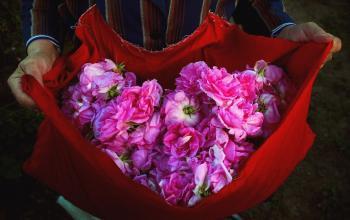Saffron is the “golden spice” not because it is gold in color, but rather because it is said that saffron is the only spice that is worth its weight in gold. And so, it is a very expensive spice in the American market.
Saffron has a high price tag because of the way it is harvested. The spice is derived from the stigma of the saffron crocus plant. The stigmas are hand harvested. It takes from 50,000 to 75,000 flowers to yield one pound of the spice, which in the U.S. retails between $500 and $1,100 a pound.
Saffron has an ancient history. Records of its usage can be dated back as far as 3,000 years. It has been used as a dye, a plant-based ink, a culinary ingredient, and a medicinal ingredient in ancient China as well as the Roman Empire.
The plant is native to Southwest Asia. Today, the principal areas that grow saffron are Iran, Spain, Italy, Morocco, Greece, Azerbaijan, and Kashmir.
The stigma itself is deep red in color. When added to a dish, it produces a golden yellow to orange hue. It has a very unique flavor and aroma, which can be described as bittersweet with grassy overtones.
There are many grades of saffron varying in quality. It typically consists of a small bunch of red strands, the stigmas. Sometimes it is infused with yellow or golden strands that come from a different plant. The saffron with fewer or no yellow strands (the purer) is considered to be the higher in quality.
Nowadays, in the West, saffron is principally used to add flavor or color. It will dye anything to a bright golden color. Because of this, it is commonly added to rice dishes of the Mediterranean and Middle-Eastern regions, as well as to liquors, such as the Italian beverage Strega, or to confections.
Probably, the most well-known dish, which features saffron as a main ingredient, is Spanish paella. Paella is a rice dish that can be made a variety of ways. It can be vegetarian or made with chicken and pork, but it is typically made with a variety of seafood common in Spain. In Italian risotto dishes, saffron is used the same way to give unique flavor and color to the rice.
Because of saffron’s high cost, people have come up with several other ideas for saffron substitutes. These include safflower, tumeric, and annatto. Many of these ingredients give food the same golden color as saffron would, but fail to impart saffron’s unique flavor.
In the United States, saffron is relatively easy to find. Many grocery stores, ethnic food stores, and spice vendors regularly keep it in stock. It is usually labeled “Spanish Saffron.” It would be wise to check the country of origin and examine it closely to see the amount of yellow strands it contains. Just because it says Spanish does not mean it came from Spain. The Spanish variety is usually of at least medium to high quality. The highest quality comes from Kashmir.
Saffron is generally sold by the half-gram, gram, or ounce. A half-gram can retail from anywhere between $2.50 and $25.00 depending on the quality and origin.
It you would like to experiment in the kitchen, I would recommend looking for the cheapest saffron from Spain. It is of a general good quality for use in any recipes that call for saffron, and unless you have a very sophisticated palate, it will be hard to tell the difference between the various varieties ranging from good to very good, to superior.
Saffron has a high price tag because of the way it is harvested. The spice is derived from the stigma of the saffron crocus plant. The stigmas are hand harvested. It takes from 50,000 to 75,000 flowers to yield one pound of the spice, which in the U.S. retails between $500 and $1,100 a pound.
Saffron has an ancient history. Records of its usage can be dated back as far as 3,000 years. It has been used as a dye, a plant-based ink, a culinary ingredient, and a medicinal ingredient in ancient China as well as the Roman Empire.
The plant is native to Southwest Asia. Today, the principal areas that grow saffron are Iran, Spain, Italy, Morocco, Greece, Azerbaijan, and Kashmir.
The stigma itself is deep red in color. When added to a dish, it produces a golden yellow to orange hue. It has a very unique flavor and aroma, which can be described as bittersweet with grassy overtones.
There are many grades of saffron varying in quality. It typically consists of a small bunch of red strands, the stigmas. Sometimes it is infused with yellow or golden strands that come from a different plant. The saffron with fewer or no yellow strands (the purer) is considered to be the higher in quality.
Nowadays, in the West, saffron is principally used to add flavor or color. It will dye anything to a bright golden color. Because of this, it is commonly added to rice dishes of the Mediterranean and Middle-Eastern regions, as well as to liquors, such as the Italian beverage Strega, or to confections.
Probably, the most well-known dish, which features saffron as a main ingredient, is Spanish paella. Paella is a rice dish that can be made a variety of ways. It can be vegetarian or made with chicken and pork, but it is typically made with a variety of seafood common in Spain. In Italian risotto dishes, saffron is used the same way to give unique flavor and color to the rice.
Because of saffron’s high cost, people have come up with several other ideas for saffron substitutes. These include safflower, tumeric, and annatto. Many of these ingredients give food the same golden color as saffron would, but fail to impart saffron’s unique flavor.
In the United States, saffron is relatively easy to find. Many grocery stores, ethnic food stores, and spice vendors regularly keep it in stock. It is usually labeled “Spanish Saffron.” It would be wise to check the country of origin and examine it closely to see the amount of yellow strands it contains. Just because it says Spanish does not mean it came from Spain. The Spanish variety is usually of at least medium to high quality. The highest quality comes from Kashmir.
Saffron is generally sold by the half-gram, gram, or ounce. A half-gram can retail from anywhere between $2.50 and $25.00 depending on the quality and origin.
It you would like to experiment in the kitchen, I would recommend looking for the cheapest saffron from Spain. It is of a general good quality for use in any recipes that call for saffron, and unless you have a very sophisticated palate, it will be hard to tell the difference between the various varieties ranging from good to very good, to superior.



